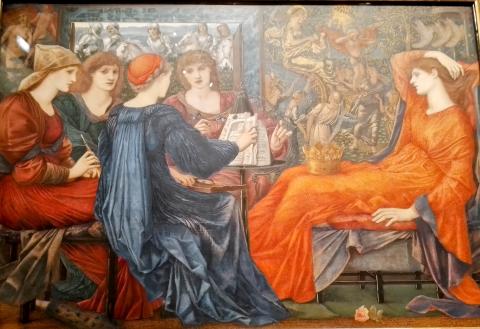Laus Veneris (1875)

Laus Veneris ('In Praise of Venus') by Sir Edward Coley Burne-Jones was painted 1873-75 (or in 1869 according to other sources). An oil on canvas, it hangs at Newcastle’s Laing Gallery and appears to be inspired by Algernon Charles Swinburne's lyrical poem of the same name.
According to the legend, a young knight called Tannhauser falls in love with Venus and lives with her until overcome by regret. Burne-Jones’ painting shows Venus and her attendants in their cramped little room looking dissatisfied and stifled, their pale melancholic faces contrasting with the splendour of their dress. They are attired in deep and vivid colours: reds, purples, and oranges, which was a use of rich colouring to which Burne-Jones did not return in his two subsequent decades. Outside, seen through a rectangular window, some knights ride by, with several already appearing captivated by the ladies within.
The painting perhaps urges us to consider the negative aspect of romantic attraction: lovesickness and obsession. Before the Fall, Adam and Eve struck a perfect balance in their love for each other and for God. They did not love each other to excess, making the other an idol, nor too little, prioritising self over spouse. Sadly, the rates, recipients and concentrations of our earthly loves are often lopsided and unhelpful, but for Christ Jesus, we can never love Him too much. Loving Him with heart, soul, body and mind can only result in our loving our fellow humans more and better.
- Log in to post comments


 Sunday Worship 10.45am & 6.00pm
Sunday Worship 10.45am & 6.00pm